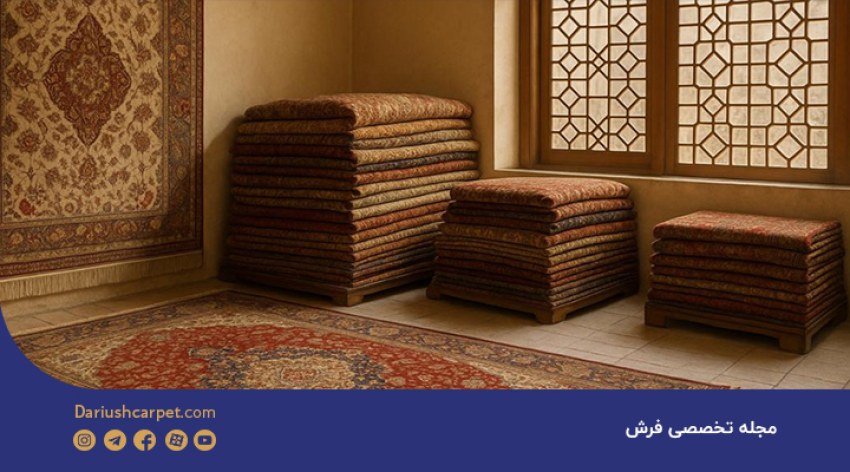The position of Iranian machine-made carpets in Arab countries

Iranian machine-made carpets with diverse and traditional designs are one of the most important products in the world's carpet market.
As a key element of interior decoration, carpets play an important role in the beauty and warmth of a home. Choosing the right carpet can have a significant impact on creating harmony between different decoration components and giving personality to the home environment.
Among these, some designs may be more popular with domestic or foreign buyers. For example, the Lachak Toranj design can be mentioned for buyers in Arab countries. This design is popular with buyers in Arab countries due to its universal appeal and beauty, and in recent years, by producing high-quality, hand-woven carpets, it has been able to gain a good position among buyers in Arab countries.
History of Iranian Machine-Made Carpets
The production of machine-made carpets in Iran dates back to the 1350s, and over the years, with the advancement of technology and innovation in designs and colors, it has been able to gain a good position. The bergamot pattern is considered one of the most authentic and famous Iranian patterns and has been widely welcomed in Arab markets.
Introducing the bergamot pattern and its features
The bergamot pattern is very desirable and has attracted attention due to its centrality in the carpet design and the balance between the surrounding patterns. This pattern gives a special identity to the carpet by using regular and consistent designs inspired by nature and traditional Iranian art.
The bergamot carpet
The bergamot carpet, as its name suggests, is made of two parts: bergamot and bergamot. The bergamot is called the middle pattern of the carpet, but bergamot means three corners and its position is in the four corners of the carpet and it is designed with the image of a quarter of the middle bergamot of the carpet. The two secondary names that always appear next to the bergamot are kalale and katibeh, which are optional in carpets with the bergamot pattern and can be added or removed according to interest in the carpet design.
What is Toranj?
In the Moein dictionary, the word bergamot is called a large flower that is located in the middle of the carpet. Shamse is another name for the middle bergamot of the carpet, which can be designed in the shapes of a circle, oval, square, almond, and several feathers, and combined with other patterns to create a new pattern.
But the notable point about bergamot carpet designs is the size and dimensions of the bergamot, which in the cities of Tabriz, Haris, the dimensions of this bergamot are larger than the carpet designs in cities such as Kashan, Isfahan.
The position of the kolale in a machine-made carpet
The position of the kolale or the head of the bergamot is above the central bergamot. The number of stigmas in the carpet can be one, but in some designs, the number of stigmas may be large and surround the bergamot. However, in some combined designs, a rhombus-shaped stigma may be seen, which is called a melon bergamot.
History of the Toranj Carpet
Traces of the toranj can be found in carpets left over from the Safavid era. This motif was first added to the carpet design during the time of Shah Abbas. But Shah Ismail Safavi was able to collect a fine collection of different toranjs used in illumination for the first time.
The place of Toranj in the beliefs of the Iranian people
After many studies conducted in the field of Iranian carpet design, it was found that the Lachak design is derived from Iranian architecture because it is designed based on famous Iranian gardens such as Pasargad, Fin Garden of Kashan, Chehelsotun Garden and other famous gardens. It should be noted that the structure of Iranian gardens is similar to the Lachak and toranj design. The bergamot symbolizes the main, water-filled pond that existed in the middle of the garden, and the Lachaks represent small ponds that were designed around the main pond.
The importance of Iranian carpets in Arab markets
Arab markets have always welcomed Iranian carpets due to their desire to use traditional and luxurious products. The bergamot pattern, with its unique features, including vibrant and soft colors along with artistic details, is a manifestation of Iranian culture and art.
The role of Arab consumer culture and taste
The consumption culture in Arab countries is based on the use of luxurious and luxurious products. Iranian carpets have artistic features and a luxurious aspect that can improve the stylishness of the home environment. Arab consumers have special preferences in purchasing machine-made carpets for their cultural and lifestyle reasons. The tastes of this group of consumers usually include the following:
- Symmetrical and classic designs
Designs such as bergamot, which have eye-catching symmetry and centrality, are very popular due to their regular structure.
- Warm and vivid colors
Gold, beige, dark red and turquoise blue colors that are in harmony with the luxurious decoration of Arab homes are very popular. Cream and white colors are also popular among buyers in Arab countries.
- High quality and durability
Arab consumers are looking for carpets that are not only beautiful but also high quality and durable.
- Details and elegance in design
Carpets with fine patterns and many details that bring to mind handcraft are more popular.
- Large dimensions for large spaces
Arab homes usually have large and luxurious halls; therefore, large-sized carpets that cover a large space are preferred.
- Inspiration from natural elements
Patterns inspired by flowers, trees, and natural elements have a special place due to the cultural interest in nature.
- Luxurious and luxurious appearance
Carpets that add a sense of luxury and splendor to the space are in line with the tastes of Arab consumers.




